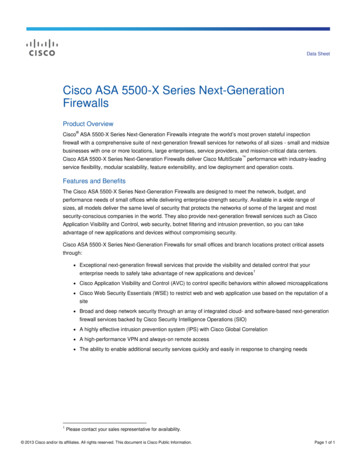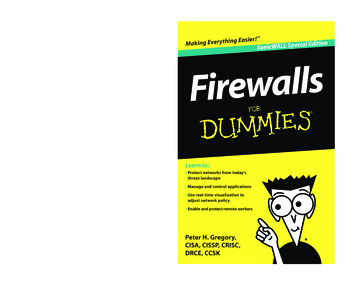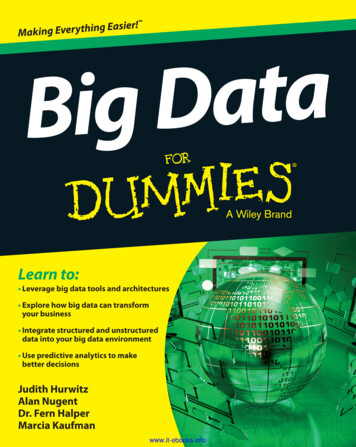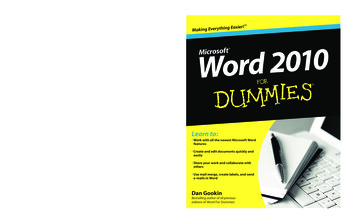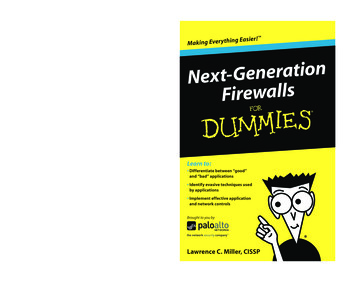
Transcription
g Easier!Making EverythinRegain control of the applicationsand users on your network!Traditional firewalls haven’t changed much overthe past 15 years and can no longer protect yournetwork. That’s because they were never designedto control all of the evasive, port-hopping, andencrypted Internet applications that are socommon today. You’ve added intrusion prevention,proxies, antivirus, URL filtering, and much more —all to no avail. It’s time to fix the firewall! What Enterprise 2.0 applications are — andhow they create new risks and challenges foryour organization Why traditional firewalls are ineffectiveagainst today’s threats — and why quickfixes and add-on capabilities don’t workOpen the book and find: How Enterprise 2.0applications create newrisks for your organization Why traditional firewallscan’t protect your network How next-generationfirewalls stand apart fromother security solutions noitareneNext-GFirewalls What features andcapabilities you needin your firewall What a next-generation firewall is — whatit isn’t, and why you need one (or more) How to get the most out of your firewall — bycreating effective policies, asking the rightquestions, and segmenting your network foroptimum performance Discover advanced features and capabilities —that make next-generation firewalls a powerfulsolution to protect your network and regaincontrolLearn to:Go to Dummies.com for videos, step-by-step examples,how-to articles, or to shop! Differentiate between “good”and “bad” applications Identify evasive techniques usedby applications Implement effective applicationand network controlsBrought to you byLawrence C. Miller, CISSP, has worked ininformation security for more than 20 years.He is the coauthor of CISSP For Dummies anda dozen other titles. He is also a Palo AltoNetworks customer and liked it so much hebought the company — well, he’s not thatrich (yet) — but he did write this book!ISBN 978-0-470-93955-0Book not for resaleLawrence C. Miller, CISSP
About Palo Alto NetworksPalo Alto Networks is the network security company. Its nextgeneration firewalls enable unprecedented visibility andgranular policy control of applications and content — by user,not just IP address — at up to 10Gbps with no performancedegradation. Based on patent-pending App-ID technology,Palo Alto Networks firewalls accurately identify and controlapplications — regardless of port, protocol, evasive tactic, or SSLencryption — and scan content to stop threats and preventdata leakage. Enterprises can for the first time embrace Web 2.0and maintain complete visibility and control, while significantlyreducing total cost of ownership through device consolidation.For more information, visit www.paloaltonetworks.com.These materials are the copyright of Wiley Publishing, Inc. and anydissemination, distribution, or unauthorized use is strictly prohibited.939550 cover.indd 2.indd 210/29/10 2:14 PM
Next-GenerationFirewallsFORDUMmIES‰by Lawrence C. Miller, CISSPThese materials are the copyright of Wiley Publishing, Inc. and anydissemination, distribution, or unauthorized use is strictly prohibited.01 939550-ffirs.indd i10/1/10 1:32 PM
Next-Generation Firewalls For Dummies Published byWiley Publishing, Inc.111 River StreetHoboken, NJ 07030-5774Copyright 2011 by Wiley Publishing, Inc., Indianapolis, IndianaPublished by Wiley Publishing, Inc., Indianapolis, IndianaNo part of this publication may be reproduced, stored in a retrieval system or transmitted in anyform or by any means, electronic, mechanical, photocopying, recording, scanning or otherwise,except as permitted under Sections 107 or 108 of the 1976 United States Copyright Act, without theprior written permission of the Publisher. Requests to the Publisher for permission should beaddressed to the Permissions Department, John Wiley & Sons, Inc., 111 River Street, Hoboken, NJ07030, (201) 748-6011, fax (201) 748-6008, or online at http://www.wiley.com/go/permissions.Trademarks: Wiley, the Wiley Publishing logo, For Dummies, the Dummies Man logo, A Referencefor the Rest of Us!, The Dummies Way, Dummies.com, Making Everything Easier, and related tradedress are trademarks or registered trademarks of John Wiley & Sons, Inc. and/or its affiliates in theUnited States and other countries, and may not be used without written permission. Palo AltoNetworks and the Palo Alto Networks logo are trademarks or registered trademarks of Palo AltoNetworks, Inc. All other trademarks are the property of their respective owners. Wiley Publishing,Inc., is not associated with any product or vendor mentioned in this book.LIMIT OF LIABILITY/DISCLAIMER OF WARRANTY: THE PUBLISHER AND THE AUTHOR MAKENO REPRESENTATIONS OR WARRANTIES WITH RESPECT TO THE ACCURACY OR COMPLETENESS OF THE CONTENTS OF THIS WORK AND SPECIFICALLY DISCLAIM ALL WARRANTIES,INCLUDING WITHOUT LIMITATION WARRANTIES OF FITNESS FOR A PARTICULAR PURPOSE.NO WARRANTY MAY BE CREATED OR EXTENDED BY SALES OR PROMOTIONAL MATERIALS.THE ADVICE AND STRATEGIES CONTAINED HEREIN MAY NOT BE SUITABLE FOR EVERY SITUATION. THIS WORK IS SOLD WITH THE UNDERSTANDING THAT THE PUBLISHER IS NOTENGAGED IN RENDERING LEGAL, ACCOUNTING, OR OTHER PROFESSIONAL SERVICES. IF PROFESSIONAL ASSISTANCE IS REQUIRED, THE SERVICES OF A COMPETENT PROFESSIONALPERSON SHOULD BE SOUGHT. NEITHER THE PUBLISHER NOR THE AUTHOR SHALL BE LIABLEFOR DAMAGES ARISING HEREFROM. THE FACT THAT AN ORGANIZATION OR WEBSITE ISREFERRED TO IN THIS WORK AS A CITATION AND/OR A POTENTIAL SOURCE OF FURTHERINFORMATION DOES NOT MEAN THAT THE AUTHOR OR THE PUBLISHER ENDORSES THEINFORMATION THE ORGANIZATION OR WEBSITE MAY PROVIDE OR RECOMMENDATIONS ITMAY MAKE. FURTHER, READERS SHOULD BE AWARE THAT INTERNET WEBSITES LISTED INTHIS WORK MAY HAVE CHANGED OR DISAPPEARED BETWEEN WHEN THIS WORK WAS WRITTEN AND WHEN IT IS READ.ISBN: 978-0-470-93955-0Manufactured in the United States of America10 9 8 7 6 5 4 3 2 1Publisher’s AcknowledgmentsFor general information on our other products and services, please contact our Business DevelopmentDepartment in the U.S. at 317-572-3205. For details on how to create a custom For Dummies book foryour business or organization, contact info@dummies.biz. For information about licensing the ForDummies brand for products or services, contact BrandedRights&Licenses@Wiley.com.Acquistions, Editorial, and MediaDevelopmentSenior Project Editor: Zoë WykesEditorial Manager: Rev MengleBusiness Development Representative:Karen HattanCustom Publishing Project Specialist:Michael SullivanComposition ServicesSenior Project Coordinator: Kristie ReesLayout and Graphics: Carl Byers,Carrie A. Cesavice, Cheryl GrubbsProofreader: Rebecca DenoncourSpecial Help from Palo Alto Networks:Chris KingThese materials are the copyright of Wiley Publishing, Inc. and anydissemination, distribution, or unauthorized use is strictly prohibited.01 939550-ffirs.indd ii10/1/10 1:32 PM
Table of ContentsIntroduction . . . . . . . . . . . . . . . . . . . . . . . . . . . . . . . . . . . . . .1About This Book . 1Foolish Assumptions . 2How This Book Is Organized . 2Chapter 1: Understanding the Evolutionof Network Security . 2Chapter 2: Defining the Applicationand Threat Landscape. 2Chapter 3: Recognizing the Challenges of LegacySecurity Infrastructures . 2Chapter 4: Solving the Problem withNext-Generation Firewalls. 3Chapter 5: Deploying Next-Generation Firewalls . 3Chapter 6: Ten Evaluation Criteria forNext-Generation Firewalls. 3Glossary . 3Icons Used in This Book . 3Where to Go from Here . 4Chapter 1: Understanding the Evolutionof Network Security . . . . . . . . . . . . . . . . . . . . . . . . . . . . .5Why Legacy Firewalls Are No Longer Effective. 6Data Leakage Is a Problem . 7Compliance Is Not Optional . 9Chapter 2: Defining the Application andThreat Landscape . . . . . . . . . . . . . . . . . . . . . . . . . . . . . .11Applications Are Not All Good or All Bad . 12Applications Are Evasive . 17Threats Are Coming Along for the Ride . 21Chapter 3: Recognizing the Challenges of LegacySecurity Infrastructures. . . . . . . . . . . . . . . . . . . . . . . . .25Whatever Happened to the Firewall? . 26Port-based firewalls have poor vision . 27Bolt-on functionality is fundamentally flawed . 28Firewall “helpers” don’t help. 29These materials are the copyright of Wiley Publishing, Inc. and anydissemination, distribution, or unauthorized use is strictly prohibited.02 939550-ftoc.indd iii10/1/10 1:32 PM
ivNext-Generation Firewalls For DummiesTraditional IPS Is a Poor Match for Today’s Threats . 30UTM Only Makes What Is Broken Cheaper. 33It’s Time to Fix the Firewall . 33Chapter 4: Solving the Problem withNext-Generation Firewalls . . . . . . . . . . . . . . . . . . . . . .35The Next-Generation Firewall . 35Application identification . 36User identification . 39Content identification . 39Policy control . 42High-performance architecture . 42What a Next-Generation Firewall Isn’t . 44Benefits of Next-Generation Firewalls . 46Chapter 5: Deploying Next-Generation Firewalls . . . . .47Safe Enablement through Smart Policies . 48Employee controls . 49Desktop controls. 50Network controls . 51Defining Your Requirements and Developing an RFP . 52Deployment Flexibility Matters . 56Addressing Mobile and Remote Users . 57Chapter 6: Ten Evaluation Criteria forNext-Generation Firewalls . . . . . . . . . . . . . . . . . . . . . .59Identify Applications, Not Ports . 59Identify Users, Not IP Addresses. 60Identify Content, Not Packets . 61Visibility . 62Control. 63Performance . 63Flexibility. 63Reliability . 64Scalability . 64Manageability . 64Glossary . . . . . . . . . . . . . . . . . . . . . . . . . . . . . . . . . . . . . . . .65These materials are the copyright of Wiley Publishing, Inc. and anydissemination, distribution, or unauthorized use is strictly prohibited.02 939550-ftoc.indd iv10/1/10 1:32 PM
IntroductionWith new Internet-based threats being launched fasterthan ever and increasingly targeting “firewall friendly”applications and application-layer vulnerabilities, traditionalfirewalls are becoming less and less capable of adequatelyprotecting corporate networks.The rapid evolution of applications and threats, coupled withthe relative stagnation of traditional security technologies,has resulted in a loss of visibility and control for IT organizations attempting to keep their enterprises secure.Despite their best efforts to restore application visibility andcontrol, and regain the advantage in protecting their networksand information assets, most organizations remain stymied.Lacking a truly innovative solution, they turn to specializedsingle-purpose security appliances that fail to fully addresstoday’s security challenges, and are not part of a comprehensive security strategy.The resulting appliance sprawl is costly and complex —characteristics that are never desirable in a solution. But intoday’s tough economic climate when organizations must domore with less — both money and IT staff — complex andcostly fixes are entirely unacceptable.Instead, an entirely new and innovative approach to networksecurity is needed — it’s time to reinvent the firewall!About This BookThis book provides an in-depth overview of next-generationfirewalls. It examines the evolution of network security,the rise of Enterprise 2.0 applications and their associatedthreats, the shortcomings of traditional firewalls, and theadvanced capabilities found in next-generation firewalls.These materials are the copyright of Wiley Publishing, Inc. and anydissemination, distribution, or unauthorized use is strictly prohibited.03 939550-intro.indd 110/1/10 1:33 PM
2Next-Generation Firewalls For DummiesFoolish AssumptionsThis book assumes you have a working knowledge of networksecurity. As such, it is written primarily for technical readerswho are evaluating potential new solutions to address theirorganizations’ security challenges.How This Book Is OrganizedThis book consists of six short chapters and an appendix.Here’s a brief synopsis of the chapters to pique your curiosity!Chapter 1: Understanding theEvolution of Network SecurityWe begin with a look at the role that firewalls traditionallyplay in network security, as well as some of the challenges ofnetwork security today.Chapter 2: Defining the Applicationand Threat LandscapeChapter 2 describes several trends affecting application development and their usage in enterprises. You find out aboutthe business benefits, as well as the security risks associatedwith various applications, and how new threats are exploiting“accessibility features” in Enterprise 2.0 applications.Chapter 3: Recognizing theChallenges of LegacySecurity InfrastructuresChapter 3 explains why traditional port-based firewalls andintrusion prevention systems are inadequate for protectingenterprises against new and emerging threats.These materials are the copyright of Wiley Publishing, Inc. and anydissemination, distribution, or unauthorized use is strictly prohibited.03 939550-intro.indd 210/1/10 1:33 PM
3IntroductionChapter 4: Solving the Problemwith Next-Generation FirewallsChapter 4 takes a deep dive into the advanced features andcapabilities of next-generation firewalls. You learn what anext-generation firewall is, what it isn’t, and how it can benefityour organization.Chapter 5: Deploying NextGeneration FirewallsChapter 5 explains the importance of security policies andcontrols, and the role of next-generation firewalls in implementing those policies and controls. You also get some helpdefining specific technical requirements for your organization,and planning the deployment of a next-generation firewall onyour network.Chapter 6: Ten Evaluation Criteriafor Next-Generation FirewallsHere, in that familiar For Dummies Part of Tens format, wepresent ten features to look for and criteria to consider whenchoosing a next-generation firewall.GlossaryAnd, just in case you get stumped on a technical term orabbreviation here or there, we include a glossary to help yousort through it all!Icons Used in This BookThroughout this book, we occasionally use icons to callattention to important information that is particularly worthnoting. Sadly, James Dean (the pop icon, not the sausage guy)These materials are the copyright of Wiley Publishing, Inc. and anydissemination, distribution, or unauthorized use is strictly prohibited.03 939550-intro.indd 310/1/10 1:33 PM
4Next-Generation Firewalls For Dummiesisn’t available to point this information out for you, so we doit instead!This icon points out information or a concept that may wellbe worth committing to memory, so don’t make like a wiseguy and fuggedaboutit — instead, make wise and don’t everforget it!You won’t find a map of the human genome or the secret tocold fusion here (or maybe you will, hmm), but if you’re seeking to attain the seventh level of NERD-vana, take note! Thisicon explains the jargon beneath the jargon.Thank you for reading, hope you enjoy the book, please takecare of your writers. Seriously, this icon points out helpfulsuggestions and useful nuggets of information that may justsave you some time and headaches.The Surgeon General has determined . . . well okay, it’s actually nothing that hazardous. Still, this icon points out potentialpitfalls and easily confused concepts.Where to Go from HereIt’s been said that a journey of a thousand miles begins with asingle step. Well, at 72 pages, reading this book is more likea quick — but informative — jaunt across your living room!Don’t worry about missing the plot, or spoiling the ending.Each chapter in this book is written to stand on its own, sofeel free to start wherever you’d like and jump ahead to thechapters that interest you most. Of course, if you’re a littlemore of a traditionalist, you could just turn the page and startat the beginning!These materials are the copyright of Wiley Publishing, Inc. and anydissemination, distribution, or unauthorized use is strictly prohibited.03 939550-intro.indd 410/1/10 1:33 PM
Chapter 1Understandingthe Evolution ofNetwork SecurityIn This Chapter Understanding why port-based firewalls have become obsolete Addressing the data leakage problem Achieving regulatory complianceJust as antivirus software has been a cornerstone of PCsecurity since the early days of the Internet, firewalls havebeen the cornerstone of network security.Today’s application and threat landscape renders traditionalport-based firewalls largely ineffective at protecting corporatenetworks and sensitive data. Applications are the conduitthrough which everything flows — a vector for our businessand personal lives — along with their associated benefits andrisks. Such risks include new and emerging threats, data leakage, and noncompliance.This chapter explains how traditional firewalls operate, whythey cannot meet today’s application and threat challenges,and how data leakage and compliance issues are defining network security and the need for a better firewall.These materials are the copyright of Wiley Publishing, Inc. and anydissemination, distribution, or unauthorized use is strictly prohibited.04 939550-ch01.indd 510/1/10 1:34 PM
6Next-Generation Firewalls For DummiesWhy Legacy Firewalls AreNo Longer EffectiveA firewall, at its most basic level, controls traffic flow betweena trusted network (such as a corporate LAN) and an untrustedor public network (such as the Internet). The most commonlydeployed firewalls today are port-based (or packet filtering)firewalls, or some variation (such as stateful inspection) ofthis basic type of firewall. These firewalls are popular becausethey are relatively simple to operate and maintain, generallyinexpensive, have good throughput, and have been the prevalent design for more than two decades.In the rapid pace of the Internet Age, nearly two decadesmeans the basic technology behind port-based firewalls ismedieval. In fact, network security is often likened to the DarkAges — a network perimeter is analogous to the walls of acastle, with a firewall controlling access — like a drawbridge.And like a drawbridge that is either up or down, a port-basedfirewall is limited to just two options for controlling networktraffic: allow or block.Port-based firewalls (and their variants) use source/destination IP addresses and TCP/UDP port information to determinewhether or not a packet should be allowed to pass betweennetworks or network segments. The firewall inspects the firstfew bytes of the TCP header in an IP packet to determine theapplication protocol — for example, SMTP (port 25), andHTTP (port 80).Most firewalls are configured to allow all traffic originatingfrom the trusted network to pass through to the untrustednetwork, unless it is explicitly blocked by a rule. For example,the Simple Network Management Protocol (SNMP) might beexplicitly blocked to prevent certain network informationfrom being inadvertently transmitted to the Internet. Thiswould be accomplished by blocking UDP ports 161 and 162,regardless of the source or destination IP address.Static port control is relatively easy. Stateful inspection firewalls address dynamic applications that use more than onewell-defined port (such as FTP ports 20 and 21). When a computer or server on the trusted network originates a sessionThese materials are the copyright of Wiley Publishing, Inc. and anydissemination, distribution, or unauthorized use is strictly prohibited.04 939550-ch01.indd 610/1/10 1:34 PM
7Chapter 1: Understanding the Evolution of Network Securitywith a computer or server on the untrusted network, a connection is established. On stateful packet inspection firewalls,a dynamic rule is temporarily created to allow responsesor replies from the computer or server on the untrustednetwork. Otherwise, return traffic needs to be explicitly permitted, or access rules need to be manually created on thefirewall (which usually isn’t practical).All of this works well as long as everyone plays by the rules.Unfortunately, the rules are more like guidelines and noteveryone using the Internet is nice!The Internet now accounts for the majority of traffic traversing enterprise networks. And it’s not just Web surfing. TheInternet has spawned a new generation of applications beingaccessed by network users for both personal and businessuse. Many of these applications help improve user and business productivity, while other applications consume largeamounts of bandwidth, pose needless security risks, andincrease business liabilities — for example, data leaks andcompliance — both of which are addressed in the following sections. And many of these applications incorporate“accessibility” techniques, such as using nonstandard ports,port-hopping, and tunneling, to evade traditional port-basedfirewalls.IT organizations have tried to compensate for deficienciesin traditional port-based firewalls by surrounding them withproxies, intrusion prevention systems, URL filtering, and othercostly and complex devices, all of which are equally ineffective in today’s application and threat landscape.Data Leakage Is a ProblemLarge scale, public exposures of sensitive or private dataare far too common. Numerous examples of accidental anddeliberate data leakage continue to regularly make nightmareheadlines, exposing the loss of tens of thousands of creditcard numbers by a major retailer, or social security numbersleaking by a government agency, health care organization, oremployer. For example, in December 2008, an improperly configured and prohibited peer-to-peer (P2P) file sharing application exposed a database of 24,000 U.S. Army soldiers’ personalinformation to the public domain. Unfortunately, such incidentsThese materials are the copyright of Wiley Publishing, Inc. and anydissemination, distribution, or unauthorized use is strictly prohibited.04 939550-ch01.indd 710/1/10 1:34 PM
8Next-Generation Firewalls For Dummiesare not isolated: the U.S. Army’s Walter Reed Medical Center,a U.S. Government contractor working on Marine One, andPfizer Corporation all had earlier high-profile breaches of asimilar nature. In all of these cases, sensitive data was leakedvia an application that was expressly prohibited by policy butnot adequately enforced with technology.Data leakage prevention (DLP) technologies are being toutedas a panacea and have captured the attention of many ITorganizations. Unfortunately, given the scope, size, and distributed nature of most enterprise datasets, just discoveringwhere the data is and who owns it is an insurmountable challenge. Adding to this challenge, questions regarding accesscontrol, reporting, data classification, data at-rest versus datain-transit, desktop and server agents, and encryption abound.As a result, many DLP initiatives within organizations progress slowly and eventually falter.Many data loss prevention solutions attempt to incorporate toomuch of the information security function (and even includeelements of storage management!) into an already unwieldyoffering. Needless to say, this broadened scope adds complexity, time, and expense — both in hard costs and in staff time.Thus, DLP technologies are often cumbersome, ironicallyincomplete (focusing mostly on the Web and e-mail), and formany organizations — overkill . . . not to mention expensive!Furthermore, many of the recent breaches caused byunauthorized and improperly configured P2P file sharingapplications wouldn’t have been prevented by the typicalimplementation of DLP technologies on the market today —because control of applications isn’t addressed.Some organizations will have to go through the effort of alarge-scale DLP implementation — which should include datadiscovery, classification, and cataloging. But for most organizations, controlling the applications most often used to leaksensitive data and stopping unauthorized transmission of private or sensitive data, such as credit card and social securitynumbers, is all that is needed. Exerting that control at trustboundaries (the network perimeter) is ideal — whether thedemarcation point is between inside and outside or internalusers and internal resources in the datacenter. The firewallsits in the perfect location, seeing all traffic traversing different networks and network segments. Unfortunately, legacyThese materials are the copyright of Wiley Publishing, Inc. and anydissemination, distribution, or unauthorized use is strictly prohibited.04 939550-ch01.indd 810/1/10 1:34 PM
9Chapter 1: Understanding the Evolution of Network Securityport- and protocol-based firewalls can’t do anything about anyof this — being ignorant of applications, users, and content.To effectively address data leakage with a firewall solution,organizations should Gain control over the applications on their network —thus limiting the avenues of data leakage Scan the applications they do want on their networks, forsensitive or private data Understand which users are initiating these applicationtransactions and why Implement appropriate control policies and technologyto prevent accidental or intentional data leakageIf enterprises could control the flow of sensitive or privatedata at the perimeter, many of the data loss incidents that regularly make the news could be avoided. Unfortunately, legacysecurity infrastructures, with traditional firewalls as the cornerstone, are ill-equipped to provide this functionality.Compliance Is Not OptionalWith more than 400 regulations worldwide mandatinginformation security and data protection requirements,organizations everywhere are struggling to attain and maintain compliance. Examples of these regulations includeHIPAA, FISMA, FINRA, and GLBA in the U.S., and the EU DataProtection Act (DPA) in Europe.Ironically, perhaps the most far-reaching, most effective, andbest-known compliance requirement today isn’t even a government regulation. The Payment Card Industry Data SecurityStandard (PCI DSS) was created by the major payment cardbrands (American Express, MasterCard, Visa, and others) toprotect companies, banks, and consumers from identity theftand fraudulent card use. And as economies rely more andmore on payment card transactions, the risks of lost cardholder data will only increase, making any effort to protectthe data critical — whether compliance-driven or otherwise.PCI DSS is applicable to any business that transmits, processes, or stores payment cards (such as credit cards or debitThese materials are the copyright of Wiley Publishing, Inc. and anydissemination, distribution, or unauthorized use is strictly prohibited.04 939550-ch01.indd 910/1/10 1:34 PM
10Next-Generation Firewalls For Dummiescards), regardless of the number or amount of transactionsprocessed.Companies that do not comply can be subject to stiff penaltiesincluding fines of up to 25,000 per month for minor violations,fines of up to 500,000 for violations that result in actual lost orstolen financial data, and loss of card-processing authorization(making it almost impossible for a business to operate).While compliance requirements are almost entirely basedon information-security best practices, it is important toremember that security and compliance aren’t the same thing.Regardless of whether or not a business is PCI compliant, adata breach can be very costly. According to research conducted by Forrester, the estimated per record cost of a breach(including fines, cleanup, lost opportunities, and other costs)ranges from 90 (for a low profile, nonregulated company) to 305 (for a high-profile, highly regulated company).Security and compliance are related, but they are not thesame th
Department in the U.S. at 317-572-3205. For details on how to create a custom For Dummies book for your business or organization, contact info@dummies.biz. For information about licensing the For Dummies brand for products or services, contact BrandedRights&Licenses
